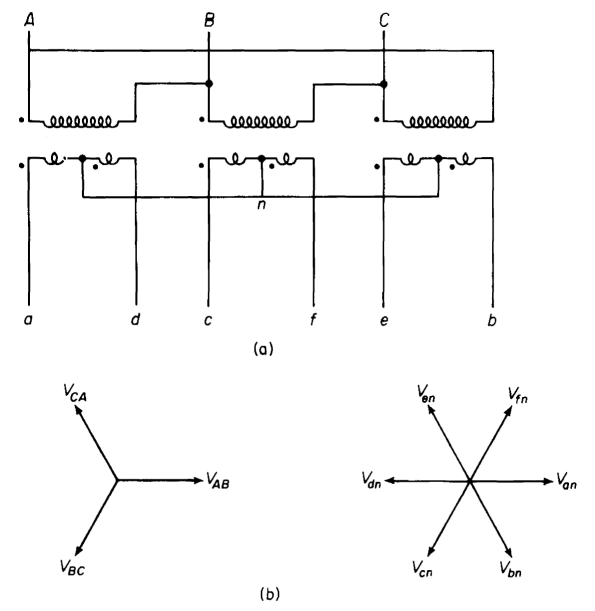| Capacitors, Magnetic Circuits, and Transformers is a free introductory textbook on the physics of capacitors, coils, and transformers. See the editorial for more information.... |

|

Home  The Transformer The Transformer  3-Phase Transformer Connections 3-Phase Transformer Connections  3-to-6-Phase Transformation 3-to-6-Phase Transformation |
|||||
| See also: 3-Phase Transformers | |||||






|
|||||
3-to-6-Phase Transformation
Large amounts of a-c power are transformed to d-c power by means of electronic rectifiers. A smoother voltage wave form is obtained on the d-c side as the number of phases is increased on the a-c input side. A greater number of phases also results in the reduction of objectionable harmonics in the alternating current. Therefore, 6-phase is preferable to 3-phase for rectification, and, consequently, there are many 6-phase rectifiers and some 12-phase rectifiers in larger installations. There are several methods of connecting transformers for obtaining 3-to-6-phase transformation. A simple arrangement known as the 6-phase star connection is shown in Fig. 6-30.
The secondaries are provided with center taps, which are connected together to form the neutral of the 6-phase side. The primaries are shown connected in delta but they may also be connected in wye. The 6-phase forked-wye or double-zigzag connection is shown in Fig. 6-31. In this arrangement, each secondary winding is divided into three equal parts and the portions that are shown parallel to each other in Fig. 6-31 constitute one of the secondaries. A 6-phase transformation may be effected by means of three single-phase transformers or by one 3-phase transformer.
|
|||||
Home  The Transformer The Transformer  3-Phase Transformer Connections 3-Phase Transformer Connections  3-to-6-Phase Transformation 3-to-6-Phase Transformation |
|||||
Last Update: 2011-02-16



